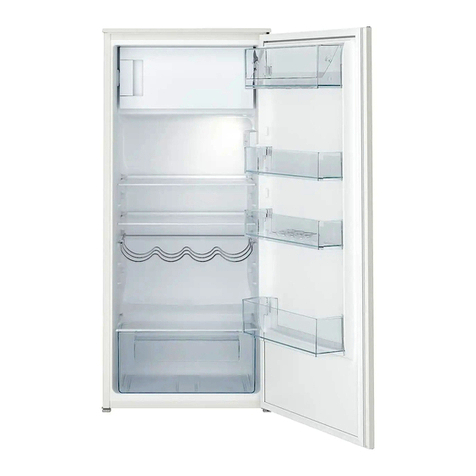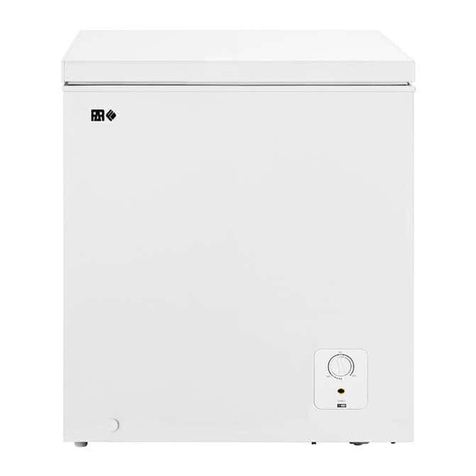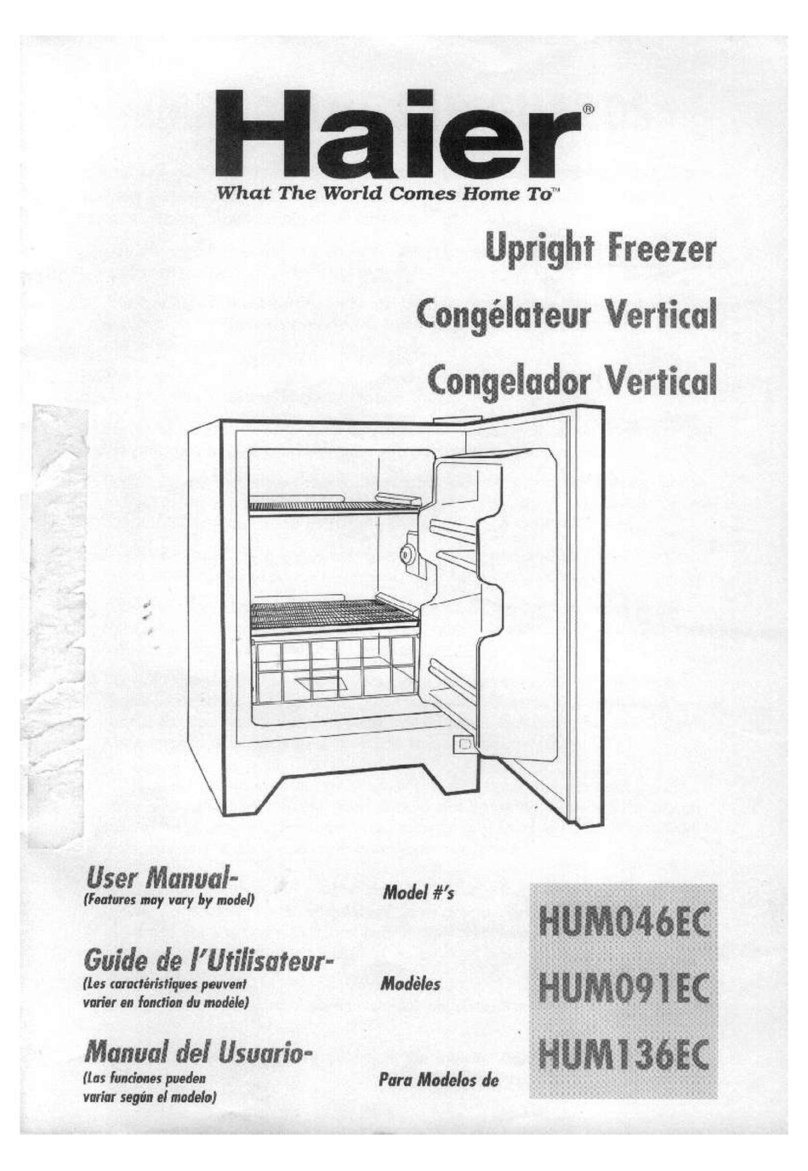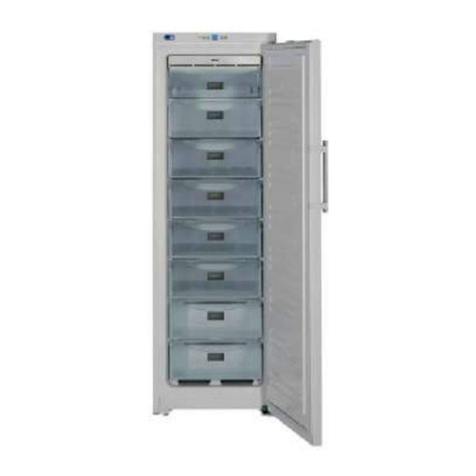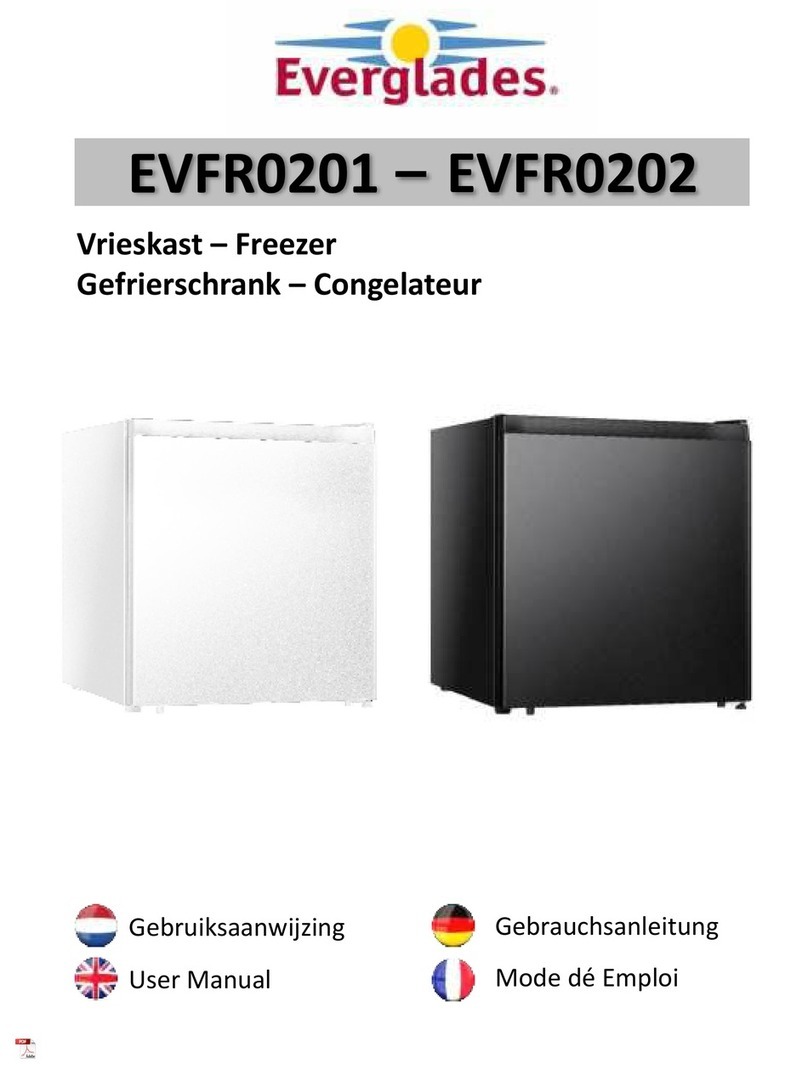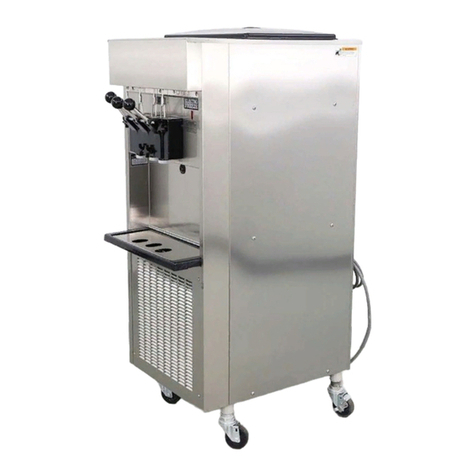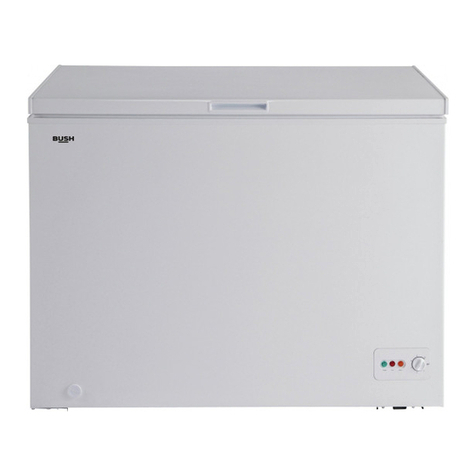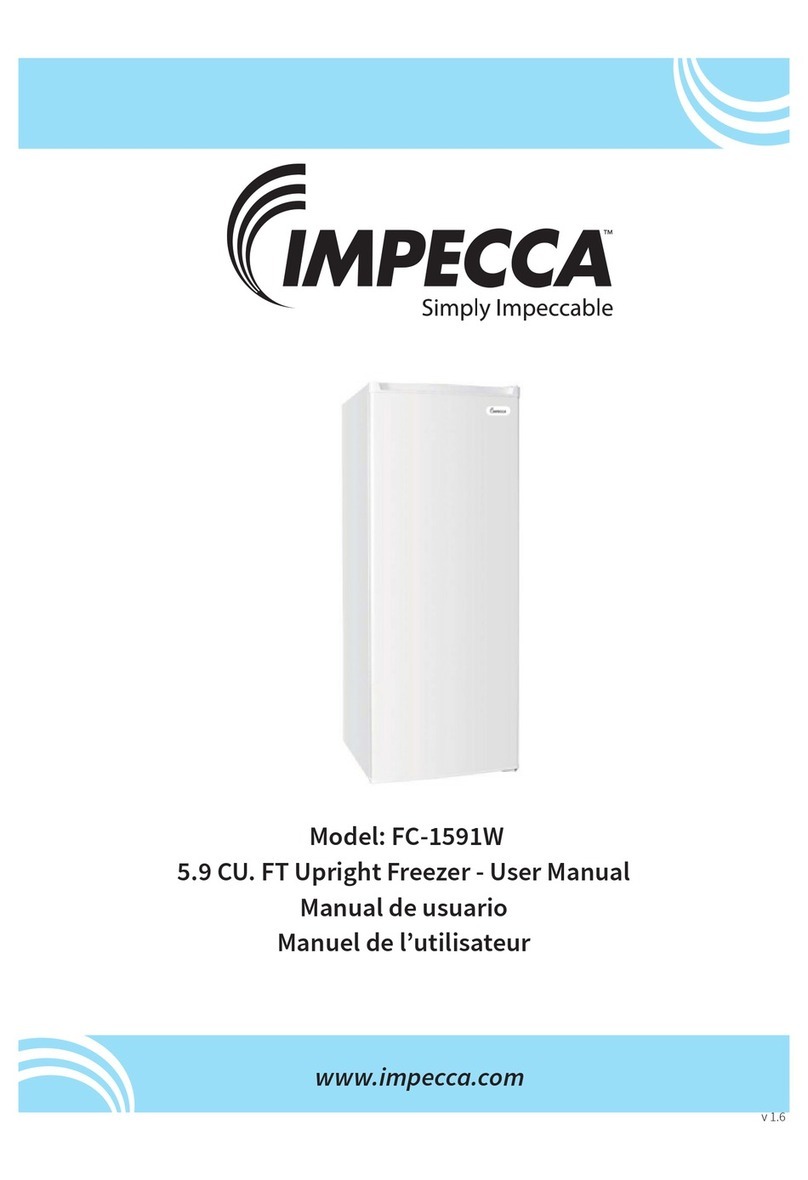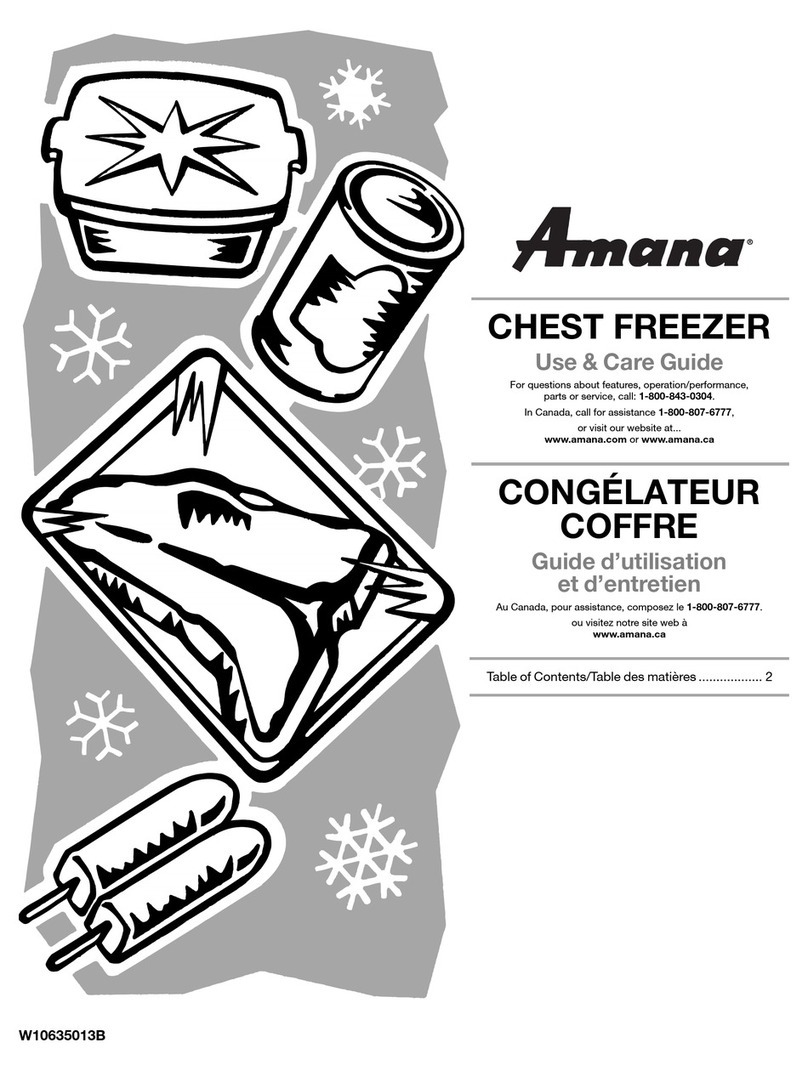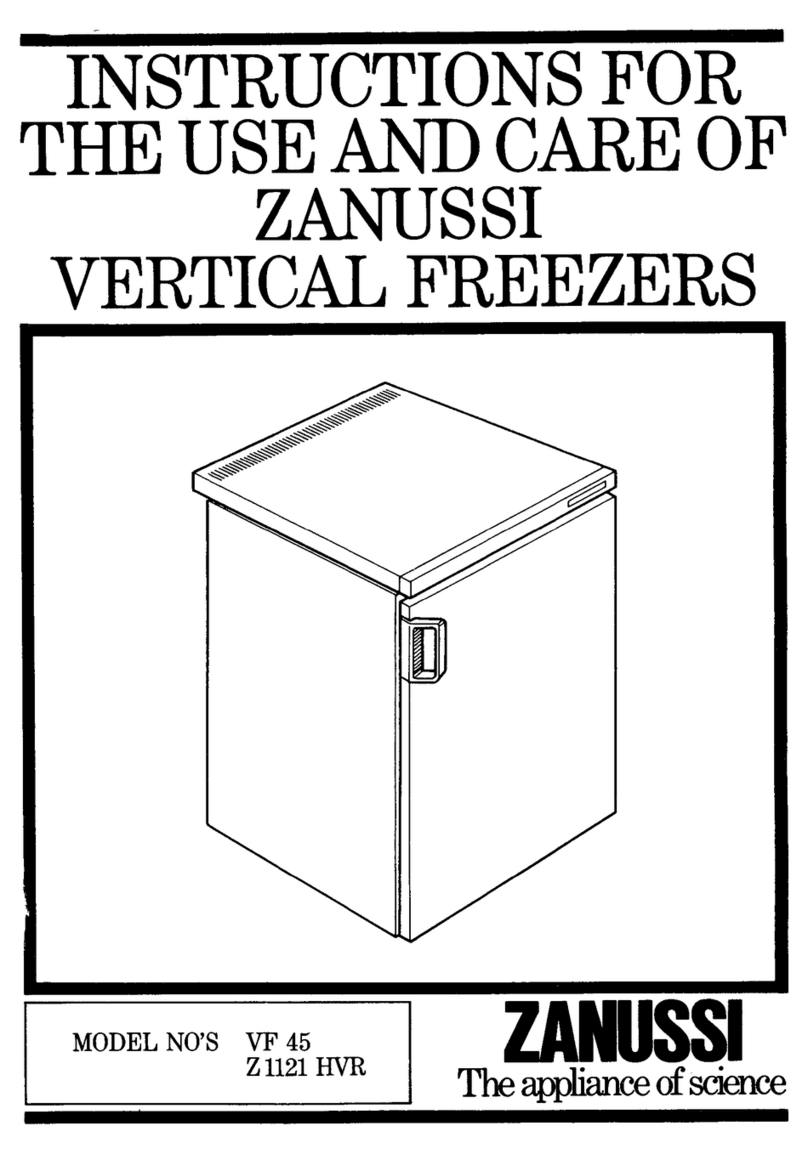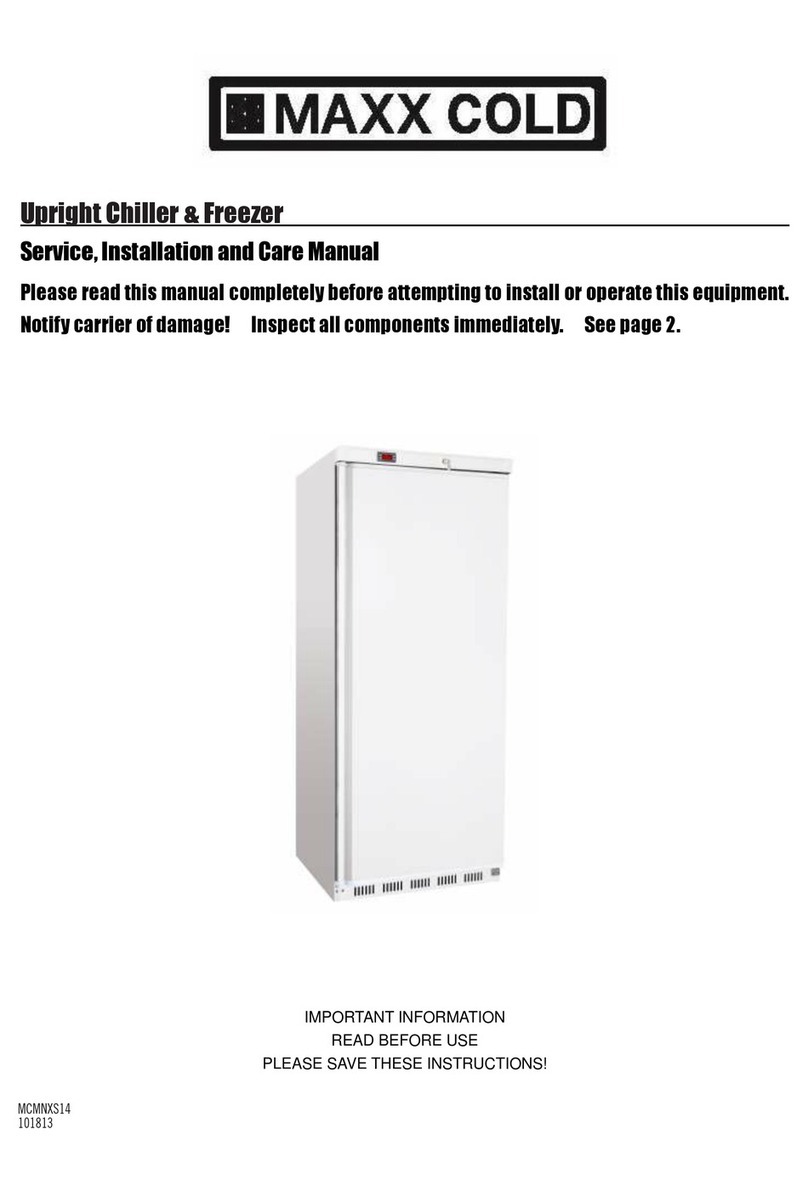Goldstar GF-161SSF User manual

Owner’s
Manual
GoldStar
FREEZER
GF-161SSF
Before
connecting,
operating
or
adjusting
your
freezer,
please
read
this
Owner's
manual
carefully.
TUV-161F-J657-00218E

TABLE
OF
CONTENTS
1
FEATURES
TABLE
:OF
CONTENTS)
02...
ccccsesscecsssescensstspanscounieet
speesisutecestuesdsceessntveens
1
.
: :
te
aye
.
:
aia
:
Hermetically
sealed
cooling
unit
with
midget
2
pole
motor
INSTALLATION
ese
seeds
evcxae
becca
tecevscceentuastuacoes
Gndedussedicosaceseencsevoctanabensts
2
e
Rustproof
anodized
"Roll-Bond"
aluminium
freezer
of
nee
SELECT
A
GOOD
LOCATION
ou...eeecceceesesscsessesssssesscssseeeeneneeceseessesrenesneuseeseee
2
thermal
conductivity
Air
Circulation
23
Setting
Up
crcccccscscccsssscessesessecsceseeeseesees
ie
*
Adjustable
thermostat
for
automatic
temperature
control
REPOSITIONING
THE
DOOR
HINGE
........ccscccescsssssssessesseeeseeeneenesseseseensensaes
2
INSTALLATION
sccossssessesesseesctercvnconesncsovernsstcessestessensncsvssedeesevevacensonseasdie
CONNECTING
THE
APPLIANCE
os
POWER
FAILURE
.......0.:secetceen
OPERATING
THE
FREEZER
.........::cccesccseeeseeeees
.
:
STORAGE
TIME.
o.ssssssssssssssssssstssestvetcanssstseeste
+
Magnetic
door
closure
gasket
TEMPERATURE
REGULATION
.
DEFROSTING.
..........cccscsssseseseseserees
ts
FEATURE:
CHARP
scscicvcctscssccesiusibetssconptcsesticcsceccesebogsdandeesonsescnsiccpveesteces
GUIDE
FOR
USING
THE
FREEZER
ou...
cc
eeeeesseseseeseseeeeeeseeeeeeees
7,8,9
SIGNAL
LAMP
ms
¢
Cabinet
bonderized
and
acrylic-enameled
according
to
the
most
modern
electrostatic
spraying
techniques.
*
High-density
polyurethane
thermal
insulation

INSTALLATION
2
SELECT
A
GOOD
LOCATION
+
Place
your
freezer
in
a
location
thet
sults
your
working
convenien-
ce.
SALTER
a
TT
Se
ST
a
tT
Ge
eS
Avoid
placing
the
unit
in
a
narrow
recess
or
near
any
heat
sources,
direct
sunlight
or
moisture.
Air
Circulation
:
Your
freezer
must
have
adequate
alr
circulation.
If
your
freezer
is
placed
in
a
recessed
area
in
the
wall,
allow
at
least
a
clearance
of
1.5
inches
or
more
above
and
at
both
sides
of
the
freezer.
Fit
the
appliance
until
the
air
grille
is
against
the
wall.
There
must
be
proper
air
circulation
around
your
freezer
to
keep
it
operating
efficiently.
For
maximum
circulation,
the
freezer
should
be
elevated
1
inch
from
floor,
especially
when
itis
carpeted.
Setting
up
To
avoid
any
vibrations,
the
unit
is to
be
set
levelled.
If
needed,
adjust
the
levelling
screws
to
compensate
for
unevenness
of
the
floor.
Itshould
be
levelled
side
to
side.
The
front
should
be
slightly
higher
than
the
rear
to
aid
in
door
closing.
Levelling
screws
can
be
turned
easily
by
tipping
the
cabinet
slightly
and
adjustments
can
be
made
with
your
fingers
to
raise
or
lower
the
cabinet.
REPOSITIONING
THE
DOOR
HINGE
Your
Freezer
is
designed
with
a
reversible
door
so
that
is
may
open
from
either
left
or
right.
It is
best
to
reposition
the
door
hinge
as
necessary
at
the
outset
since
it
is
inconvenient
to
do
so
later.
To
change
the
door
hinge
please
refer
to
the
diagram
below
and
proceed
as
follows:

INSTALLATION
3
REPOSITIONING
THE
DOOR
HINGE
(continued)
1.
Remove
all
loose
fittings
from
inside
the
appliance
10.
Replace
the
Adjustable
Foot
(A),
setting
it
at
approximately
2.
Carefully
lay
the
appliance
on
its
back
on
the
original
packing
°
(You
will
need
assistance
to
achieve
this).
Take
care
not
to
11.
Carefully
stand
the
appliance
up
(you
will
need
assistance
to
damage
the
pipework
by
keeping
it
clear
of
the
floor.
do
this)
and
position
it
in
its
permanent
location.
3.
Unscrew
and
remove
the
Adjustable
Foot
(A).
12.
Check
that
the
door
opens
and
closes
easily.
Ensure
that
the
‘ :
door
seal
does
not
bind
on
the
hinge
side
creating
gaps
4.
Remove
the
Lower
Hinge
(D)
by
unscrewing
the
2
Bolts
(B).
which
would
allow
air
into
the
interior.
Adjust
the
hinges
if
5.
Remove
the
Leg
(H)
by
unscrewing
the
bolt
fixing
it
(c)
necessary.
,
6.
Gently
pull
the
door
downwards
to
remove
it
This
appliance
should
be
stood
ona
firm, level
floor
with
sufficient
7.
Before
refitting
the
door,
swap
the
Hinge
Cap
(F)
by
prising
SPace
for
free
airflow
around
it.
Avoid
positions
close
to
walls
or
2
: :
afin
ge
corners.
There
must
be
sufficient
room
for
free
ventilation
parti-
it
from
its
current
location
and
repositioning
it
on
the
other
cularly
at
the
back.
The
unit
should
be
located
away
from
Lenk
side
of
the
door.
Care
should
be
taken
not
to
damage
the
heat
sources,
such
as
cookers,
radiators
and
direct
sunlight.
If
the
adjacent
surfaces
when
removing
the
Hinge
Cap.
unit
is
positioned
where
the
temperature
is
too
low,
condensation
: ;
ae
will
form
on
the
outside
of
the
cabinet.
Normal
room
temperature
8.
Unscrew
the
Upper
Hinge
pin
(G)
and
screw
it
into
the
is
recommended
.
opposite
side
hole
in
the
top
of
the
cabinet.
Avoid
locations
which
may
be
affected
by
draughts
or
dampness
9.
Now
secure
the
Lower
Hinge
(D)
to
the
cabinet
using
the
2
as
this
will
impair
the
efficiency
of
the
product.
Bolts
(B).

INSTALLATION
CONNECTING
THE
APPLIANCE
Connect
the
power
supply
cord
or
plug
to
the
outlet.
Don’t
double
up
with
other
appliances
on
the
same
outlet.
In
the
event
of
an
electrical
short
circuit,
earthing
reduces
the
risk
of
electric
shock
by
providing
an
escape
wire
for
the
electric
current.
If
this
appliance
is
equipped
with
a
cord
having
an
earthing
wire
with
an
earthing
plug,
you
must
plug
into
an
outlet
that
is
properly
installed
and
grounded.
If
this
appliance
has
no
grounding
(earthing)
plug
with
a
cord
having
a
grounding
(earthing)
wire,
appliance
must
be
earthed
another
way.
:
Do
not
use
an
extension
cord
ir
possible,
connect
the
freezer
to
its
own
individual
appliance
circuit
so
that
the
other
appliances
or
a
heavy
load
of
household
lights
will
not
cause
an
overload,
that
might
interrupt
the
electrical
current.
Also
a
loose
connector
might
result
from
doubling
up
with
another
appliance
in
the
outlet.
!
Improper
use
of
the
earthing
plug
can
result
in
an
electric
shock.
Consult
a
qualified
electrician
or
service
person
if
the
grounding
instructions
are
not
completely
understood
or
if
you
have
doubts
on
whether
the
appliance
is
properly
grounded.
POWER
FAILURE
In
case
of
a
power
failure,
the
good
thermal
insulation
of
your
freezer
will
ensure
the
preservation
of
the
food
for
at
least
12
hours
free
of
any
alteration
as
long
as
the
freezer
door
is
not
opened.
If
the
power
is
off
for
a
longer
period
of
time,
the
food
must
be
used
as
soon
as
possible.
If
raw,
cook
it
right
away
and
refreeze
it.

OPERATING
THE
FREEZER
3)
STORAGE
TIME
This
appliance
carries
the
freezer
symbol
BES]
indicating
that
it
is
suitable
both
for
long
term
storage
(4-STAR;
up
to
3
months)
of
pre-frozen
foods
and
for
home
freezing
of
fresh
food.
Freezing
capacity
of
this
appliance
is
9kg/24h(20Ib/24h).
Generally
speaking,
long-term
storage
is
possible
for
up
to
3
months,
but
this
will
vary
with
the
nature
of
the
packaged
food,
so
always
follow
the
manufacturer’s
recommended
storage
time
gi-
ven
on
the
packet.
An
indication
of
the
thermostat
setting
is
necessary
to
obtain
the
prescribed
temperature
in
the
frozen
food
cabinet.
In
practice,
some
variations
will
occur
in
the
amount
of
food
which
can
be
stored
because
of
the
different
shape
and
densities
of
the
foods.
It
is
necessary
to
store
commercially
frozen
food
in
accordance
with
the
instructions
given
on
the
packets
that
you
buy.
A
rise
of
temperature
of
the
frozen
food
packs
during
defrosting
may
short-
en
the
storage
life
and
the
estimate
given
above
and
the
frozen
food
manufacturer’s
estimate
may
not
then
apply.
!
Do
not
store
uncovered
containers
of
liquid
or
hot
food.
Cool
the
latter
beforehand
down
to
room
temperature:
you
will
avoid
the
formation
of
condensation
and
save
energy.
SEITE
SILLY
PL
OORT
SPS
NLS
ALE LEA
IIL
DESPISES
IIE
SEI
LELLES
NATE
AIL
IEEE
DISET,
TEMPERATURE
REGULATION
The
freezer
temperature
will
vary
depending
on
the
quantity
of
the
food
stored
and
on
the
frequency
with
which
the
door
is
opened,
the
ambient
temperature
and
the
location
of
the
freezer.
The
control
dial
ist
marked.0
(off),
1,
2,3.
It
allows
you
to
select
the
desired
temperature
setting.
¢
Setting
0:
Off
+
Setting
1:
Highest
freezer
temperature,
warmest
setting.
*
Setting
2:
Suitable
freezer
temperature,
is
the
best
temperature
for
the
storage
of
food
on
the
fridge
section.
+
Setting
3:
Lowest
freezer
temperature,
coldest
setting.
DEFROSTING
From
time
to
time
the
frost
should
be
removed
from
the
walls
and
shelves
inside
the
appliance.
Do
not
use
sharp
objects
for
this
purpose
since
they
could
perma-
nently
damage
the
appliance.
Use
the
plastic
scraper
provided.
To
defrost
the
appliance
completely
(this
should
be
done
at
least
once
or
twice
a
year),
disconnect
the
plug
and
leave
the
door
open
until
the
frost
has
completely
thawed.
To
speed
up
the
defrosting
operation,
one
or
more
trays
of
warm
water
may
be
placed
inside
the
appliance.
During
the
whole
operation
it
is
advisable
to
wrap
any
frozen
food
in
several
pages
of
newspaper
and
put
them
ina
cool
place.
As
the
inevitable
rise
of
temperature
shortens
their
life,
these
should
be
consumed
as
soon
as
possible.

FEATURE
CHART
Fast
Freezer
Compartment
Scraper
Temperature
Control
Dial
fi
aq
w\
fi
Ice
Cubes
Tray
Magnetic
Door
Seal
Stroge
Information
Card
Storage
Basket
il
Adjustable
Feet

FEATURE
CHART
6
Fast
Freezer
Compartment
Scraper
Temperature
Control
Dial
Ice
Cubes
Tray
Magnetic
Door
Seal
2
——
ss
|
Stroge
Information
Card
3
Storage
Basket
|
ONAN
Leg
Adjustable
Feet

GUIDE
FOR
USING
THE
FREEZER
ITEM
PACKING
Veai/lamb
chops
each
slice
in
polythene
and
then
in
aluminium
foil
(4
to
6
slices)
Veai/lamb
cutlets
each
slice
in
polythene
and
then
in
aluminium
foil
(4
to
6
slices)
Minced
meat
in
aluminium
containers,
covered
with
polythene
Heart
and
liver
polythene
bags
polythene
or
aluminium
foil
Chickens
and
turkey
{in
aluminium
foil
Ducks
and
goose
in
aluminium
foil
wo
np
o
HH
HANGING
TIME
(DAYS)
freshly
minced
CONSERVATION
(MONTHS)
2-3
1
hour
per
cm.
of
thickness
‘
©
THAWING
TIME
1
hour
per
cm.
of
thickness
2-4
hours
1
hour
per
cm.
of
thickness
2-3
hours
1
hour
per
cm.
of
thickness
slowly
in
refrigerator
not
necessary
6-7
hours
very
slowly
in
refrigerator
very
slowly
in
refrigerator

GUIDE
FOR
USING
THE
FREEZER
8
ITEM
PACKING
HANGING
TIME
|
CONSERVATION
THAWING
TIME
(DAYS)
(MONTHS)
:
Pheasant,
partridge,
In
aluminium
foil
1-3
9
very
slowly
in
refrigerator
wild
duck
:
3-4
Hares
and
rabbits
in
aluminium
foil
very
slowly
in
refrigerator
|
ae
6
Deers
and
bucks
aluminium
or
polythene
foil
5-6
9
very
slowly
in
refrigerator
Big
fish
aluminium
or
polythene
foil
-
4-6
very
slowly
in
refrigerator
Small
fish
polythene
bags
-
not
necessary
2-3.
-
12
Shell
fish
in
aluminium
or
plastic
containers,
3
very
slowly
in
refrigerator
covered
by
salt
water
Fried
fish
polythene
bags
directly
in
pan
,

GUIDE
FOR
USING
THE
FREEZER
)
SIGNAL
LAMP
Signal
Lamp
is
localed
at
the
front
of
the
freezer,
it
shows
the
degree
of
temperature
of
the
inside.
YELLOW
LAMP
GREEN
LAMP
RED
LAMP
QUICK
FREEZING
S/W
(ON)
QUICK
FREEZING
(OFF)
YELLOW
LAMP
Push
the
Frost
symbol(:k)
of
the
quick
freezing
switch,
your
freezer
will
begin
quick
freezing
as
Yellow
Lamp
is
turned
on.
This
operation
in
a
"ON"
state
of
the
quick
freezing
switch
will
be
continued,
it's
irrelative
to
the
temperature
of
the
inside
and
to
the
NOTCH
of
the
dial.
After
quick
freezing,
you
must
push
the
switch
in
the
opposite
direction
to
remove
operating.
Then
Yellow
Lamp
is
off.
GREEN
LAMP
This
Lamp
indicate
a
stationary
operation
state.
RED
LAMP
This
Lamp
is
turned
on
when
the
temperature
of
the
inside
is
higher
than
its
proper
temperature.
Turn
the
thermostat
dial
to
the
higher
NOTCH.
(NOTE
:
It's
irrelative
to
the
temperature
of
the
inside
that
Red
Lamp
can
be
turned
on
in
two
hours
after
operating.)

GENERAL
INFORMATION
IMPORTANT
SAFEGUARDS
This
freezer
is
for
domestic
use
only.
Do
not
use
the
appliance
if
it
is
not
operating
correctly
or
has
been
damaged
-
disconnect
from
the
mains
supply
and
ask
for
a
service
call.
nated
liquids
(fizzy
drinks
etc.)
into
the
freezer,
=
Never
leave
the
door
open.
Open
it
as
infrequently
as
possible.
You
will
save
energy
since
less
cold
is
released.
Do
not
use
knives
or
other
sharp
instruments
to
lever
out
ice
trays.
Avoid
touching
the
cooling
surfaces
with
your
hands,
espe-
cially
if
they
are
wet.
.
Some
products,
such
as
ice
lollies,
should
not
be
consumed
too
cold.
Ice,
if
consumed
immediately
after
removal
from
storage,
can
possibly
result
in
a
low-temperature
skin
burn
condition.
!
Always
disconnect
from
the
mains
supply
when
defrosting,
clea-
ning
or
carrying
out
maintenance.
lan
empty
freezer
is
a
very
dangerous
attraction
to
children.
Remove
either
gaskets,
latches,
lids
or
door
from
unused
appli-
ance,
or
take
some
other
action
that
will
make
it
harmiess.
It
can
be
dangerous
to
place
sealed
vessels
that
contain
carbo-
©
10
CLEANING
Before
use,
the
interior
surfaces
and
fittings
should
be
washed
with
a
lukewarm
solution
of
1
teaspoonful
of
bicarbonate
of
soda
(not
washing
soda)
in
1
pint
(0.5
litres)
of
water.
Do
not
wash
plastic
parts
in
very
hot
water
and
do
not
expose
them
to
heat.
Detergent
and
soap
should
not
be
used
as
they
may
leave
traces
of
odour
which
could
contaminate
food.
Abrasive
cleaniers
should
not
be
used
because
they
may
scratch
the
finish.
Dry
thoroughly
before
use
(including
fittings
as
well
as
the
inte-
rior).
It
is
advisable
to
give
the
exterior
of
the
cabinet
a
light
coat
of
wax
polish,
especially
if
the
appliance
is
located
ina
garage
or
outhouse
where
condensation
may
form.
IF
YOU...
...Go
on
Vacation
During
average
length
vacations,
you
will
probably
find
it
best
to
leave
the
freezer
in
operation.
When
you
are
going
to
go
for
an
extended
period,
follow
these
steps.
Remove
all
food.
Disconnect
the
power
supply
cord.
Clean
interior
thoroughly
including
defrost
pan.
Leave
door
OPEN
to
prevent
odor
formation.
...Move
Remove
or
securely
fasten
down
all
loose
items
inside
the
freezer.
To
avoid
damaging
the
levelling
screws
turn
them
all
the
way
into
the
base.

BEFORE
CALLING
FOR
SERVICE
11
Often,
service
calls
can
be
avoided!
If
you
feel
the
freezer
is
not
operating
properly,
check
these
possible
causes
first:
Is
there
a
cabinet
odor?
Certain
food
produces
odor:
cover
open
dishes
of
food:
interior
may
need
cleaning.
Has
a
house
fuse
blown
or
circuit
breaker
tripped?
Has
the
power
cord
been
removed
or
loosened
from
the
elec-
trical
wall
outlet?
Is
the
air
circulation
within
the
cabinet
blocked
by
over-
crowded
shelves
or
by
paper
or
other
covering
on
the
shelves?
Is
there
an
obstruction
in
the
opening
at
the
front
of
the
cabinet
base?
Is
the
radiant
heat
through
tube
condenser,
located
on
the
side
of
the
cabinet,
obstructed
in
any
way?
Have
the
doors
been
kept
open
more
than
normally
necessary?
Is
the
temperature
control
dial
set
on
a
proper
position?
Does
the
cabinet
vibrate?
Does
it
need
to
be
levelled?
Exces-
sive
running
time
may
be
controlled
if
the
conditions
mentio-
ned
above
are
checked
periodically.
Table of contents


